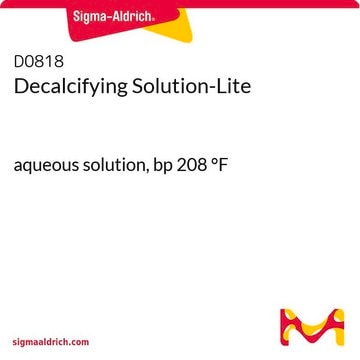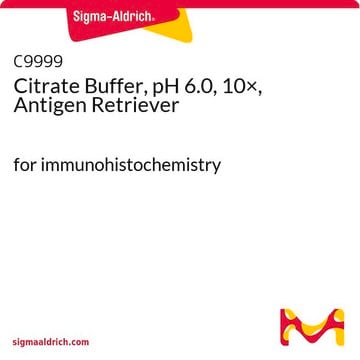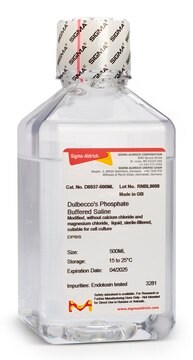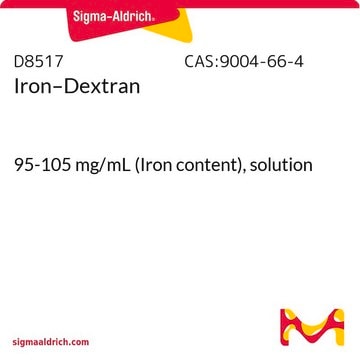The Osteomoll instructions recommend using a needle to check for demineralization of calcium in tissue, but a more accurate method involves a chemical end point determination to ascertain the absence of calcium in the tissue. Tissues can also be examined by X-ray to detect the presence of calcium. A cost-effective chemical method involves using 5 ml of the used decalcifying solution and neutralizing it with 5 ml of concentrated ammonium hydroxide. Litmus paper can be used to verify a neutral pH. Then, 5 ml of saturated ammonium oxalate is added, and the solution is allowed to stand for 30 minutes. If the solution is turbid after 30 minutes, it indicates that calcium (calcium oxalate) is still present in the tissue. The process of decalcification should be continued, periodically checking for completion. Smaller tissue pieces should be checked more frequently, while it is unnecessary to check larger tissue pieces as frequently.
1.01728
OSTEOSOFT®
mild decalcifier-solution for histology
Wybierz wielkość
269,00 zł
Wybierz wielkość
About This Item
269,00 zł
Polecane produkty
Poziom jakości
Formularz
liquid
IVD
for in vitro diagnostic use
kolor
dark red
pH
7.0-7.3 (20 °C in H2O)
gęstość
1.10 g/mL at 20 °C
Zastosowanie
diagnostic assay manufacturing
hematology
histology
temp. przechowywania
15-25°C
Opis ogólny
Decalcification is necessary for optical microscopic examinations of hard tissue in routine histological procedures. For the decalcification of sensitive, calcium-containing tissues, such as iliac crest biopsies, OSTEOSOFT® can be used. Its formulation is based on EDTA. Its pendant, OSTEOMOLL®(Product number 1.01736), can be used for the decalcification of hard tissue such as teeth and bone as its formulation is based on formaldehyde and acetic acid. The amount of OSTEOSOFT®needed is dependent upon on the size, type and thickness of the material. Both solutions are color-coded, to distinguish them from each other, fixatives and solvents used in the histological laboratory. OSTEOSOFT® is color-coded yellow, OSTEOMOLL® is color-coded blue. Whereby OSTEOSOFT® preserves the antigen structures in the tissue, thus, an IHC analysis can be performed, OSTEOMOLL® will be used for tissues that are not destined for antibody analysis.
Both decalcifiers can be used for clinical diagnostic purposes and in laboratory accreditation processes as they are certified and registered as IVD and CE product. OSTEOSOFT® is used only once and fresh solution must be used for each tissue. The quantity of OSTEOSOFT® required is dependent on the size, type, and density of the respective material. For more details, please see instructions for use (IFU). The IFU can be downloaded from this webpage.
Informacje prawne
Hasło ostrzegawcze
Danger
Zwroty wskazujące rodzaj zagrożenia
Zwroty wskazujące środki ostrożności
Klasyfikacja zagrożeń
Eye Dam. 1 - STOT RE 2 Inhalation
Organy docelowe
Respiratory Tract
Kod klasy składowania
12 - Non Combustible Liquids
Klasa zagrożenia wodnego (WGK)
WGK 2
Temperatura zapłonu (°F)
Not applicable
Temperatura zapłonu (°C)
Not applicable
Certyfikaty analizy (CoA)
Poszukaj Certyfikaty analizy (CoA), wpisując numer partii/serii produktów. Numery serii i partii można znaleźć na etykiecie produktu po słowach „seria” lub „partia”.
Masz już ten produkt?
Dokumenty związane z niedawno zakupionymi produktami zostały zamieszczone w Bibliotece dokumentów.
Klienci oglądali również te produkty
Powiązane treści
Learn about the criticality of biological tissue staining for research and clinical pathology using standard and special stains and dyes.
Dowiedz się więcej o krytycznym znaczeniu barwienia tkanek biologicznych w badaniach i patologii klinicznej przy użyciu standardowych i specjalnych barwników.
-
What is the method for determining when decalcification is complete when using a decalcification solution, such as Osteosoft, Osteomoll, or Decalcifying Solution Light?
1 answer-
Helpful?
-
Active Filters
Nasz zespół naukowców ma doświadczenie we wszystkich obszarach badań, w tym w naukach przyrodniczych, materiałoznawstwie, syntezie chemicznej, chromatografii, analityce i wielu innych dziedzinach.
Skontaktuj się z zespołem ds. pomocy technicznej












